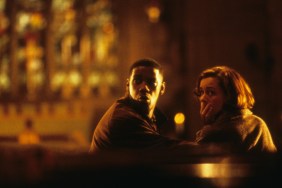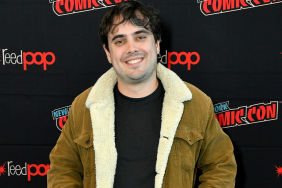
Kathyrn Bigelow’s The Hurt Locker hits New York and Los Angeles theaters this Friday, June 26 and will then hit 17 other cities on July 10. Unfortunately slow roll outs such as this mean many of you will either have to wait for it to find success in these 19 early cities before it comes to your town, or even worse, have to wait for it on DVD and Blu-ray. I say “even worse” because this is a film you will want to see in theaters as director Kathryn Bigelow brings us an increasingly immersive piece of cinema, a fact which became the primary subject of our conversation when she came to Seattle back in late May.
The Hurt Locker follows an elite Army Explosive Ordinance Disposal team in present-day Baghdad and comes as the result of some on-the-ground research done by journalist/screenwriter Mark Boal whose previous work includes the story for 2007’s In the Valley of Elah. “Mark was on an embed, and I was aware of his journalism prior to his embed and a big fan of it,” Kathryn told me in discussing how she first became aware of the project. “When he went to Iraq to spend some time with the bomb squad instantly my filmmaker antenna went up. First, I thought I hope he survives and if he does… let’s talk about this!” She said laughing.
Discussions were fruitful and the two found a way to turn the stories Mark came back with into a highly dramatic and thrilling piece of cinema all while bringing to light the work done by a group of highly skilled volunteers we hear very little of. “You hear words like roadside bomb, IED and EOD, but you don’t quite know the mechanics. It’s not an air-to-ground. It’s not ground-to-ground,” Bigelow said before breaking it down in layman’s terms. “It’s a group who patrols areas for suspicious objects, wires, rubble piles, a new patch of asphalt, anything that looks unusual from before. Then, when something is suspicious, the coordinates are called in and the bomb squad goes out and identifies it and either blows it in place, takes it to a bomb disposal range, like you have in the movie, or disarms it [in the field] and there is no margin for error. You add to that these psychological profiles of the bomb techs who arguably have the most dangerous job in the world and yet the military, exclusively now, is voluntary. So you add that component and it’s really interesting.”
She mentions psych profiles, but one of the more impressive elements to The Hurt Locker is the fact it doesn’t preach at the audience as much as it wills the audience to become an active participant in the film. The opening sequence to the film does more in 10 minutes than most films do for their entire running time as it sets the audience up comfortably, plays with your patience as you begin to feel the heat and then delivers a blow that reverberates throughout the rest of the film.
“That opening scene does many things, but, in my opinion, I think it was cleverly modulated in that it gives the audience that sort of armature by which to understand the rest of the movie and understand the process and the protocol and the characters and the psychology,” Bigelow explains. “You’re like, here’s a team leader, he’s very relaxed, easy with his men, easy in his own skin, but when he’s replaced by somebody who has an almost unimaginable kind of recklessness, bravado and swagger [it likens to] a bull rider approach to bomb disarmament. All of a sudden you’re destabilized, but you understand the mechanics of what it should be.”
Despite these character flaws in the film’s lead played superbly by Jeremy Renner, Bigelow adds, “In this particular individual you’ve got that recklessness combined with a profound skill set that will keep you alive.” It is these character strengths and flaws Bigelow and Boal use to allow the audience to get to know the characters, and not through the use of dialogue or moments of grand exposition which typically lessen the impact. Bigelow agrees saying, “The plot comes to a grinding halt, or your narrative flow comes to a grinding halt. The beauty of [Mark’s screenplay] is keeping it really natural and we would spend time with these guys and they’re not stopping [in the middle of disarming a bomb] to have ruminations about their past or their private thoughts.”
Along with keeping the dialogue to a minimum when it wasn’t necessary, Bigelow also keeps Marco Beltrami’s score to a minimum. “I think Marco did a wonderful job, but a score can be repetitive and almost mathematical and that can relax you in a way,” Bigelow explains. “There’s this sound and it’s repeated by this sound, but if you take that repetition away there’s nothing you have to hang on to. I actually think [the score] can diffuse tension if not used properly. All of a sudden it’s like Where’s that music coming from? and suddenly it’s not really immersive anymore. I’m instantly thrust way back into the theater and I’m watching as opposed to being catapulted into the dust and the sand and the dirt. If you’re standing in the middle of Baghdad looking at an IED 300 meters away there’s no score.”
What The Hurt Locker leaves you with is a sense of loneliness amidst madness and while it carries several of the themes previous war-based films have hit upon, it does so without ever saying so. Instead of setting out to shoot a film with a message Bigelow shot a film about a group of men doing extraordinary work and at the same time manages to make it vastly entertaining.
“Mark comes back and has these incredible stories and these amazing characters,” Bigelow remembers. “We fused some and then fictionalized because ultimately it’s meant to be a movie and not a documentary, but at the same time we wanted to keep it extremely, almost hyper-reportorial. So it feels very much like an immersive, boots-on-the-ground, you-are-there, look-at-that conflict.”

Taking advantage of the talents of Barry Ackroyd (Paul Greengrass’s cinematographer on United 93), The Hurt Locker was shot using four handheld cameras in the Jordanian desert where Kathryn tells me she must have lost 20 pounds due to all the walking as temperatures reached upwards of 110-120 degrees. Bigelow said, “Bomb disarmament protocols state [your team must set up] approximately 300 meters [away] and I wanted the audience to have a palpable understanding of the geography of this process so you can have some investment. Again, it’s that you-are-there feeling, you’re training the audience to observe the environment the way the soldier or the bomb tech does. Therefore you’re both wary, on-guard and sometimes inappropriately anxious or appropriately anxious depending on the situation.”
If there is anything you feel while watching The Hurt Locker it is anxious, and Bigelow has created something visually spectacular that keeps you riveted throughout never knowing just who is going to live or die. She taps into all of your insecurities and your knowledge of how a film is “supposed” to work and plays on those expectations.
I hope you get to experience in the theater as it is certainly a film best not left for home video.
For more on The Hurt Locker click here. I have attached the trailer directly below.










